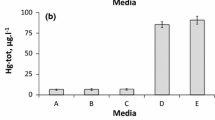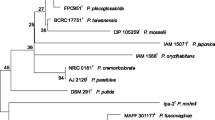Abstract
Insertion of a bacterial lux operon into the chromosome of Pseudomonas putida mt-2 holding TOL plasmid, yielded a new bioluminescent strain of P. putida BLU. Both in the cultures containing toluene and m-toluic acid as the sole carbon sources, P. putida BLU showed the same specific growth rate and cell yield as those of the wild strain. The bioluminescence output in the cell growth phases correlated with the cell concentration, indicating that the bioluminescent P. putida BLU can be monitored and quantified in a mixed culture in real time by the luminescence detection.
Similar content being viewed by others
References
Blouin K, Walker SG, Smit J, Turner RFB (1996) Characterization of in vivo reporter systems for gene expression and biosensor application based on luxAB luciferase genes. Appl. Environ. Microbiol. 62: 2013–2021.
Crawford RL, Crawford DL (1996) Bioremediation: Principles and Applications, 1st ed. New York: Cambridge University Press.
Hatta DM, Xing X-H, Yoshikawa Y, Matsumoto K (1999) Analysis of a simple biodegradation process for removal of volatile organic chemicals from wastewater based on gas-stripping principle. J. Biosci. Bioeng. 87: 519–524.
Jansson JK, Prosser JI (1997) Quantification of the presence and activity of specific microorganisms in nature. Mol. Biotechnol. 7: 103–120.
King JMH, Digrazia PM, Applegate B, Burlage R, Sanseverino J, Dunbar P, Larimer F, Sayler GS (1990) Rapid, sensitive bioluminescence reporter technology for naphthalene exposure and biodegradation. Science 249: 778–781.
Lindow SE (1995) The use of reporter genes in the study of microbial ecology. Mol. Ecol. 4: 555–566.
Munakata-Marr J, McCarty PL, Shields MS, Reagin M, Francesconi SC (1996) Enhancement of trichloroethylene degradation in aquifer microcosms bioaugmented with wild type and genetically altered Burkholderia cepacia G4 and PR1. Environ. Sci. Technol. 30: 2045–2052.
Natarajan MR, Wu W-M, Sanford R, Jain MK (1999) Degradation of biphenyl by methanogenic microbial consortium. Biotechnol. Lett. 21: 741–745.
Shaw JJ, Kado CI (1986) Development of a Vibrio bioluminescence gene-set to monitor phytopathogenic bacteria during the ongoing disease process in a non-disruptive manner. Bio/Technology 4: 560–564.
Shaw JJ, Settles LG, Kado CI (1988) Transposon Tn4431 mutagensis of Xanthomonas campesteris pv. campestris: characterization of a nonpathogenic mutant and cloning of a locus for pathogenicity. Mol. Plant-Microbe Interact. 1: 39–45.
Smets BF, Rittmann BE, Stahl DA (1993) The specific growth rate of Pseudomonas putida PAW1 influences the conjugal transfer rate of the TOL plasmid. Appl. Environ. Microbiol. 59: 3430–3437.
Soda S, Ike M, Fujita M (1998) Effects of inoculation of a genetically engineered bacterium on performance and indigenous bacteria of a sequencing batch activated sludge process treating phenol. J. Ferment. Bioeng. 86: 90–96.
Stephenson D, Stephenson T (1992) Bioaugmentation for enhancing biological wastewater treatment. Biotechnol. Adv. 10: 549–559.
Unge A, Tombolini R, Molbak L, Jansson JK (1999) Simultaneous monitoring of cell number and metabolic activity of specific bacterial populations with a dual gfp-luxAB marker system. Appl. Environ. Microbiol. 65: 813–821.
Van Dyke MI, Lee H, Trevors JT (1996) Survival of lux-marked Alcaligenes eutrophus H850 in PCB-contaminated soil and sediment. J. Chem. Technol. Biotech. 65: 115–122.
Xiao ZY, Hatta DM, Xing X-H, Yoshikawa Y, Matsumoto K (2000) A membrane bioreactor with novel modules for effective biodegradation of toluene. Biochem. Eng. J. 5: 83–88.
Xing X-H, Yoshino T, Puspita NF, Unno H (1995) Behavior of 2,4-D degradation and nitrogen conversion by an activated sludge. Biotechnol. Lett. 17: 335–340
Xing X-H, Yoshino T, Tanji Y, Unno H (1997) Analysis of horizontal gene transfer in a mixed bacterial culture for effective biodegradation of xenobiotic chemicals. In: Proceedings of Asia-Pacific Biochemical Engineering Conference '97 (ISBN: 7–302–02700–5), pp. 1099–1102.
Xing X-H, Inoue T, Tanji Y, Unno H (1999) Enhanced microbial adaptation to p-nitrophenol by using activated sludge retained in porous carrier particles and simultaneous removal of nitrite released from degradation of p-nitrophenol. J. Biosci. Bioeng. 87: 372–377.
Author information
Authors and Affiliations
Rights and permissions
About this article
Cite this article
Xing, XH., Tanaka, T., Matsumoto, K. et al. Characteristics of a newly created bioluminescent Pseudomonas putida harboring TOL plasmid for use in analysis of a bioaugmentation system. Biotechnology Letters 22, 671–676 (2000). https://doi.org/10.1023/A:1005679518447
Issue Date:
DOI: https://doi.org/10.1023/A:1005679518447




